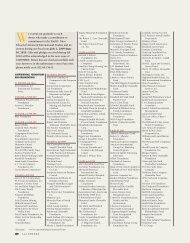Download Current Issue - SAIS
Download Current Issue - SAIS
Download Current Issue - SAIS
You also want an ePaper? Increase the reach of your titles
YUMPU automatically turns print PDFs into web optimized ePapers that Google loves.
Boosting Food Security<br />
This leads us to the discussion of food<br />
security, identified as a critical area by<br />
international organizations, intergovernmental<br />
organizations, such as the<br />
G-20 major economies, national governments<br />
and many nongovernmental<br />
organizations. The 1996 World Food<br />
Summit, held in Rome, concluded:<br />
“Food security exists when all people,<br />
at all times, have physical and economic<br />
access to sufficient, safe and<br />
nutritious food to meet their dietary<br />
needs, and food preferences for an<br />
active and healthy life.”<br />
When there are international price<br />
spikes in key agricultural products,<br />
concerns are well-founded that an<br />
increase in what people in poor countries<br />
pay for basic staples will exacerbate<br />
poverty. During the 2007–08<br />
surge in food prices, an estimated<br />
additional 300 million people found<br />
themselves among the food-insecure.<br />
Nevertheless, when food prices were<br />
at their lowest level in recent years<br />
in 2002, there were still 833 million<br />
food-insecure individuals.<br />
In developing economies, food<br />
security is ultimately a problem<br />
of poverty: Households are food-<br />
insecure because they are poor. A rise<br />
in the price of food will hurt households<br />
that are net food purchasers and<br />
lack alternative means of income support<br />
outside agriculture. The policy<br />
implications are clear: To render such<br />
households more food-secure, they<br />
must diversify their income sources.<br />
In sum, agricultural growth is<br />
essential to poverty reduction and<br />
food security. Agricultural productivity<br />
as well as accommodating institutions,<br />
infrastructure and policy<br />
measures are important sources of<br />
progress in this area. This is not to say<br />
that development in less-developed<br />
countries is uniquely about agriculture;<br />
manufacturing and services also<br />
help reduce poverty rates and ultimately<br />
become increasingly important<br />
as countries’ incomes rise above<br />
the lowest levels. Moreover, policy<br />
also plays a direct role (for example,<br />
targeted poverty reduction programs<br />
such as Oportunidades in Mexico or<br />
Bolsa Família in Brazil) and an indi-<br />
rect role (for instance, conservative<br />
monetary policies that keep inflation<br />
low and liberal trade policy that allows<br />
developing economies to specialize in<br />
labor-intensive goods).<br />
Nevertheless, a focus on agriculture<br />
is usually necessary for any effective<br />
poverty-reduction scheme. The battle<br />
to achieve the first of the U.N. Millennium<br />
Development Goals—halving<br />
global poverty by 2015—will be<br />
fought in the countryside of most<br />
nations. n<br />
Dalila Cervantes-Godoy is an agriculture<br />
policy analyst in the Development<br />
Division of the Trade and Agriculture<br />
Directorate at the Organisation for<br />
Economic Co-operation and Development<br />
in Paris. Michael G. Plummer ’82 is the<br />
Eni Professor of International Economics<br />
at the Bologna Center, currently on leave<br />
of absence from <strong>SAIS</strong>, and head of the<br />
Development Division of the Trade and<br />
Agriculture Directorate at the OECD.<br />
The views in this article are uniquely<br />
those of the authors.<br />
2011–2012 53



